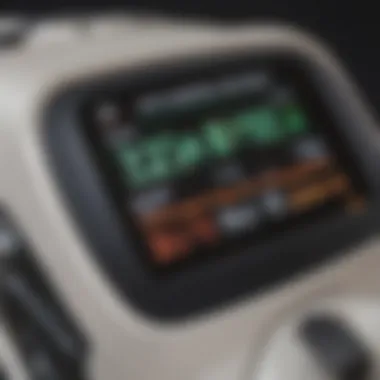Your Definitive Handbook for Selecting the Perfect Home Oximeter


Nutrition Advice
- Discover the optimal foods to include in your diet to support overall health and well-being. Explore a range of nutrient-rich ingredients that boost immunity and promote longevity. Gain insights into creating a well-balanced meal plan that is tailored to your specific dietary needs, whether you are aiming to achieve weight loss or enhance muscle growth.
- Delve into the significance of fueling your body with essential nutrients that not only sustain but elevate your energy levels. Uncover the secret to crafting nutritious and delicious snacks that will keep you satiated throughout the day. Learn about the best sources of proteins, carbohydrates, and fats that synergistically work to optimize your physical performance and cognitive function.
- Sample carefully curated meal plans designed to align with your fitness objectives and promote optimal health. Reimagine your approach to nutrition with expert guidance on portion control, meal timing, and food combinations. Elevate your culinary experience with flavorful recipes that prioritize both taste and nutritional value.
Understanding Oximeters
In the realm of health and wellness, understanding oximeters holds paramount importance. Oximeters are indispensable tools that enable individuals to monitor their oxygen saturation levels and pulse rate accurately from the comfort of their homes, providing valuable insights into their overall health status. This section will delve into the intricacies of oximeters, shedding light on their significance in proactive healthcare management.
What is an Oximeter?
An oximeter is a medical device designed to measure the oxygen saturation in a person's blood without the need for invasive procedures. It typically clips onto a person's finger, toe, or earlobe, utilizing light wavelengths to determine the percentage of oxygen-bound haemoglobin in the blood. By understanding how much oxygen is being carried through the bloodstream, individuals can assess their respiratory function and overall well-being with ease.
How Do Oximeters Work?
Oximeters operate based on a simple yet sophisticated principle called spectrophotometry. This technique involves emitting two types of light through the skin and measuring the absorption levels of oxygenated and deoxygenated haemoglobin. The device then calculates the oxygen saturation by comparing the two absorption levels. This non-invasive and quick process allows users to obtain real-time information about their oxygen levels, empowering them to take necessary actions promptly.
Benefits of Owning an Oximeter
The ownership of an oximeter offers a myriad of benefits for individuals concerned about their health. Firstly, it provides a convenient and efficient way to monitor oxygen saturation levels at home, reducing the need for frequent visits to healthcare facilities. Secondly, oximeters can aid in the early detection of potential respiratory issues or underlying health conditions, enabling timely interventions and treatment. Additionally, regular monitoring with an oximeter can instill a sense of control and awareness regarding one's health status, fostering proactive healthcare practices for improved well-being.
Key Features to Look for
When delving into the realm of oximeters for home use, it is imperative to consider key features that ensure accurate and reliable readings. Among the crucial elements to look for are accuracy and precision, display and usability, battery life and power source, as well as portability and design.


Accuracy and Precision
The cornerstone of any oximeter is its ability to provide precise and accurate readings of oxygen saturation levels and pulse rate. Opt for devices that offer high precision to ensure you are monitoring your vitals effectively. Choose oximeters with advanced sensor technology that delivers consistent and reliable results, giving you peace of mind regarding the accuracy of the data you receive.
Display and Usability
Equally essential is the display and usability of the oximeter. A clear and easy-to-read display is vital for convenient monitoring, especially for individuals with varying levels of eyesight. Look for devices with intuitive interfaces and user-friendly features that make operation hassle-free. Consider factors such as screen size, brightness, and user prompts to enhance your overall experience with the oximeter.
Battery Life and Power Source
Another critical aspect to evaluate is the battery life and power source of the oximeter. Opt for devices that offer extended battery life to minimize the hassle of frequent recharging or battery replacements. Consider the type of battery required and the availability of power sources to ensure continuous and uninterrupted monitoring of your vital signs.
Portability and Design
t confers Atp essentiell in oximeter unnoticedungs and rdesign t21.
Types of Oximeters
Types of oximeters play a crucial role in the realm of health and wellness, especially concerning home use. An oximeter is a device that aids individuals in monitoring their oxygen saturation levels and pulse rate conveniently in a domestic environment. There are various types of oximeters available in the market, each catering to specific needs and preferences of users. Understanding the differences and benefits of these types is essential when selecting the best oximeter for home use.
Finger Pulse Oximeters
Finger pulse oximeters are compact and portable devices designed to be clipped onto a finger to measure oxygen saturation levels and pulse rate. These oximeters are easy to use and provide quick and accurate readings, making them ideal for home monitoring. They are especially popular among individuals with respiratory conditions, athletes, and those interested in tracking their fitness levels. When choosing a finger pulse oximeter, factors such as accuracy, display clarity, and fingertip size compatibility should be considered to ensure efficient use and reliable results.
Handheld Oximeters


Handheld oximeters are versatile devices that offer more features and functionalities compared to finger pulse oximeters. These oximeters come with a separate sensor that can be attached to various body parts to measure oxygen saturation levels and pulse rate. Handheld oximeters are commonly used in medical settings but are also suitable for home use, providing detailed insights into one's health status. When selecting a handheld oximeter, factors like sensor attachment capabilities, data storage options, and battery life are important considerations to enhance usability and convenience.
Wrist-worn Oximeters
Wrist-worn oximeters are wearable devices that monitor oxygen saturation levels and pulse rate from the wrist. These oximeters are designed for continuous monitoring and are favored by individuals looking for a hands-free monitoring solution. Wrist-worn oximeters offer comfort and convenience, allowing users to track their vital signs throughout the day easily. Factors such as battery life, data synchronization with mobile devices, and comfort of wearing should be taken into account when choosing a wrist-worn oximeter to ensure seamless integration into daily routines and reliable monitoring.
Choosing the Right Oximeter for Your Needs
The selection of an appropriate oximeter for personal use is a critical decision that directly impacts one's ability to monitor vital signs conveniently within the comfort of their home environment. In a world that places significant emphasis on individual health and well-being, having access to reliable equipment like an oximeter can provide peace of mind and valuable health insights. Ensuring the accuracy, functionality, and compatibility of the chosen oximeter with one's specific needs is paramount in this decision-making process. Whether it is for regular monitoring due to health conditions or simply as a proactive measure, the right oximeter can be a valuable asset in maintaining optimal wellness.
Medical Grade vs. Consumer Grade
The distinction between medical-grade and consumer-grade oximeters plays a crucial role in the selection process. Medical-grade oximeters adhere to stricter regulatory standards and are typically utilized in professional healthcare settings. While these devices offer the highest level of accuracy and reliability, they may come at a higher cost. On the other hand, consumer-grade oximeters are designed for personal home use and may provide accurate readings suitable for general monitoring purposes. Understanding the differences between these two categories is essential in choosing the most appropriate oximeter based on individual requirements and budgetary constraints.
Budget Considerations
When considering the purchase of an oximeter for home use, budget considerations inevitably come into play. Prices can vary significantly depending on the brand, model, and features of the device. It is important to strike a balance between affordability and quality to ensure that the selected oximeter meets both functional requirements and financial constraints. Conducting thorough research on available options, comparing prices, and evaluating the long-term value of the investment are pivotal steps in making an informed decision that aligns with both health goals and budgetary considerations.
Brand Reputation and Customer Reviews
The reputation of the brand and feedback from existing users are valuable sources of insight when selecting an oximeter. Establishing trust in the manufacturer's reputation for quality and reliability can instill confidence in the chosen device's performance. Additionally, customer reviews and testimonials offer real-world perspectives on the usability, accuracy, and durability of the oximeter under consideration. By leveraging feedback from reputable sources and evaluating the overall satisfaction of users, individuals can make a well-informed choice that aligns with their expectations and trust in the brand's reputation.
Additional Features and Accessories


Beyond basic functionality, the inclusion of additional features and accessories can enhance the utility and convenience of an oximeter for home use. Features such as data storage capacity, connectivity options, display customization, and alarm settings can offer added value for users seeking advanced monitoring capabilities. Likewise, accessories like carrying cases, lanyards, and protective covers contribute to the portability, protection, and longevity of the oximeter. Evaluating the importance of these supplementary features based on individual preferences and intended usage scenarios can guide the selection of an oximeter that truly meets one's holistic health monitoring needs.
Maintenance and Care Tips
In the realm of health and wellness, the discussion around oximeters wouldn't be complete without emphasizing the critical aspect of maintenance and care tips. Whether you are a health professional, a wellness coach, or a fitness trainer, ensuring the proper upkeep of your oximeter is paramount to its accuracy and longevity. By following specific maintenance protocols, you not only guarantee the reliability of the device but also contribute to the precision of the readings it provides. Taking care of your oximeter is a proactive approach to safeguarding your health and well-being, aligning with the proactive mindset prevalent in today's healthcare practices.
Cleaning and Disinfecting
When delving into the intricacies of maintenance and care tips for your oximeter, one cannot overlook the importance of cleaning and disinfecting. Regular cleaning of the device, especially the sensor area that comes in contact with the skin, is crucial to prevent any buildup of dirt, oils, or contaminants. Using a gentle cleanser and a soft cloth to wipe the oximeter helps maintain its hygienic integrity. Additionally, disinfecting the device at specified intervals, following manufacturer guidelines, ensures that it remains free from harmful pathogens while in use. Proper cleaning and disinfection not only preserve the accuracy of the readings but also promote a safe health monitoring environment, crucial for home use.
Calibration and Battery Replacement
In the context of maintenance and care for your oximeter, calibration and battery replacement emerge as significant considerations. Regular calibration of the oximeter is essential to verify its accuracy and alignment with industry standards. This process involves adjusting the device to ensure that it provides precise readings consistently. Battery replacement is another key aspect of maintaining an oximeter. Ensuring that the batteries are in optimal condition guarantees uninterrupted functionality of the device. Monitoring battery life and following recommended replacement timelines prevent any sudden disruptions in usage when monitoring your oxygen saturation levels and pulse rate. By adhering to proper calibration and battery replacement practices, you uphold the performance and reliability of your oximeter, essential for accurate health monitoring at home.
Conclusion
In wrapping up this extensive guide on selecting the best oximeter for home use, it is crucial to emphasize the paramount importance of monitoring vital signs in maintaining optimal health and well-being. As individuals take charge of their health, owning an oximeter plays a vital role in tracking oxygen saturation levels and pulse rate conveniently from the comfort of their homes. By considering various factors discussed in this guide, individuals can make informed decisions to safeguard their health efficiently.
With the increasing demand for at-home health monitoring tools, the significance of choosing the right oximeter cannot be overstated. Accuracy, precision, display usability, battery life, power source, portability, and design are essential features to prioritize when selecting an oximeter. Understanding the differences between medical-grade and consumer-grade oximeters, along with budget considerations, brand reputation, customer reviews, and additional features, assists individuals in making astute choices tailored to their specific needs.
When selecting an oximeter for personal use, individuals must not overlook the maintenance and care aspect. Proper cleaning, disinfecting, calibration, and regular battery replacements are imperative to ensure the oximeter functions optimally and provides accurate readings consistently. By adhering to these maintenance and care tips, individuals can extend the longevity and reliability of their oximeter, enabling continuous monitoring of vital signs with precision and effectiveness.
Final Thoughts
As we reflect on the crucial role of oximeters in home health monitoring, it becomes evident that these devices empower individuals to take proactive steps towards optimizing their health. The ease of tracking oxygen saturation levels and pulse rate conveniently at home enhances awareness and facilitates early detection of any health deviations.
When delving into the realm of selecting the ideal oximeter, individuals must approach the process with a discerning eye, considering factors such as accuracy, usability, portability, and additional features that align with their specific requirements. Evaluating between medical-grade and consumer-grade options, factoring in budget constraints, brand reputation, and real-world user feedback helps individuals in making well-rounded decisions that cater to their health monitoring needs effectively.
Moreover, the commitment to maintaining and caring for the oximeter is a critical aspect often overshadowed. Regular cleaning, disinfecting, calibration, and ensuring adequate battery power are essential practices to sustain the functionality and reliability of the oximeter in the long run.
In essence, choosing the best oximeter for home use transcends mere device selection; it embodies a proactive approach towards personal well-being and health management. By utilizing the insights and guidelines presented in this guide, individuals can navigate the process effortlessly, ensuring they equip themselves with a quality oximeter that becomes a valuable ally in their journey towards a healthier lifestyle.







